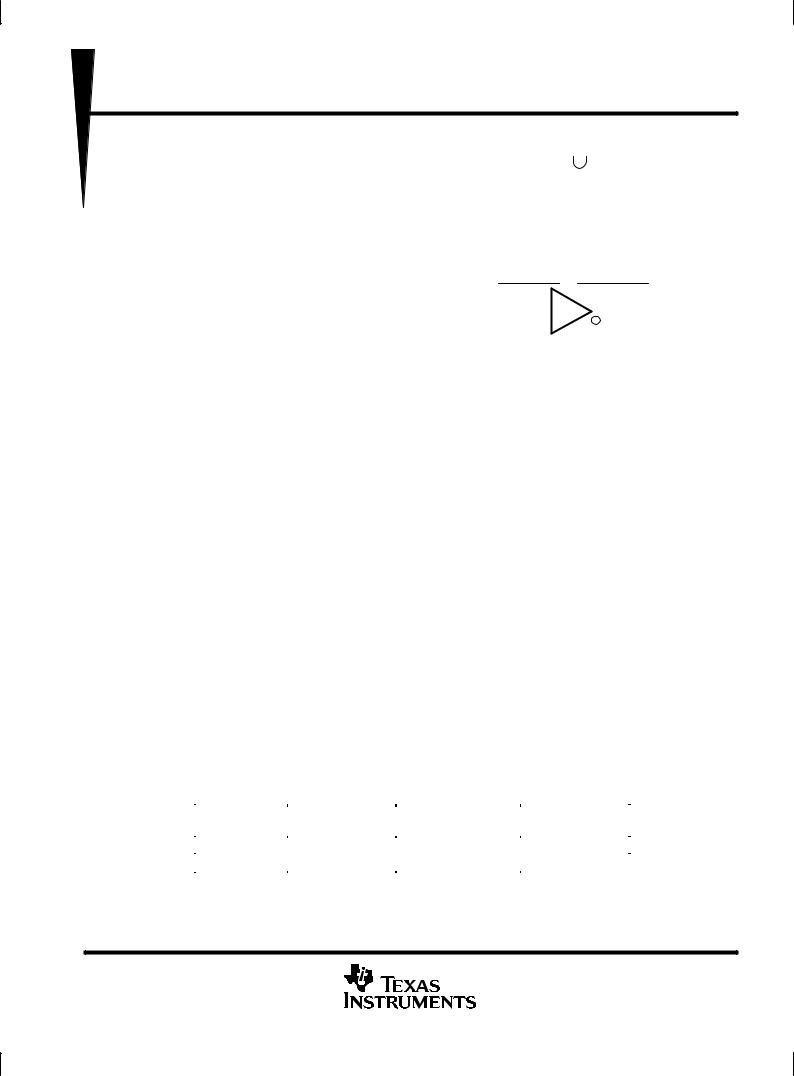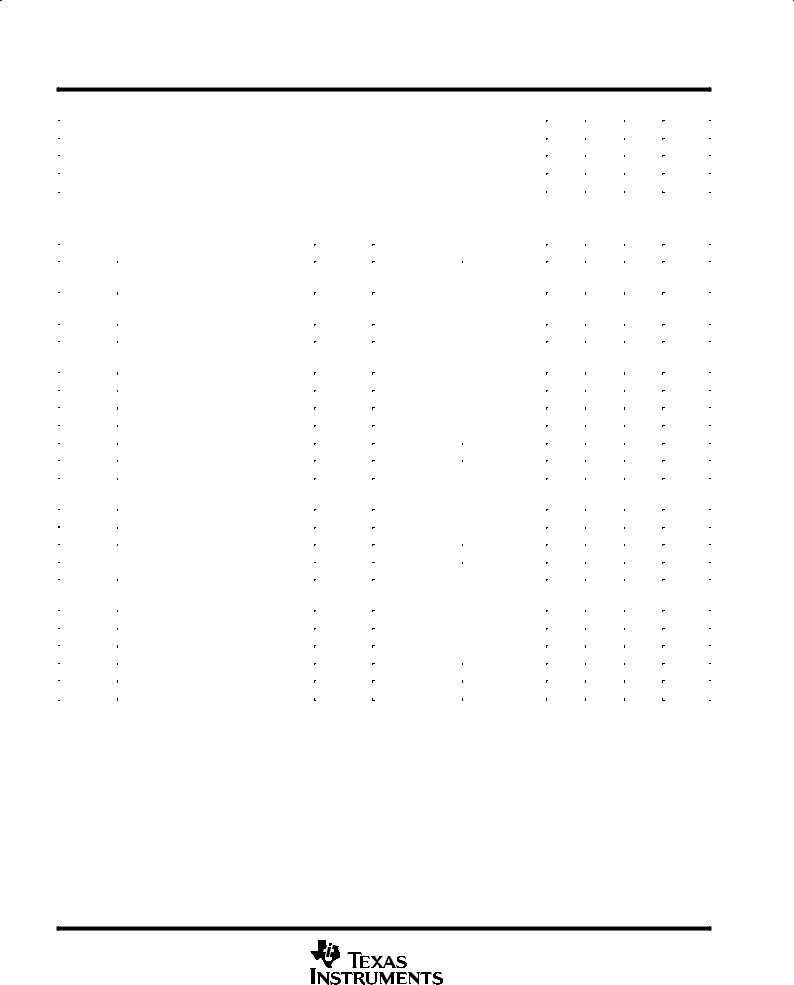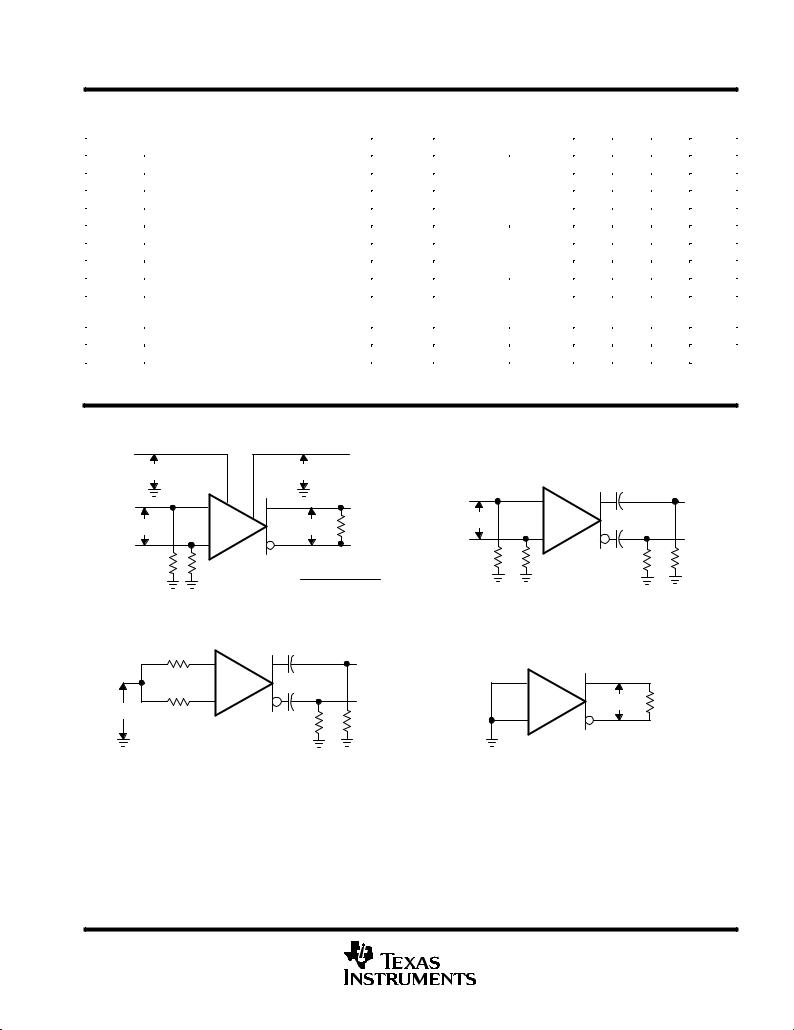Texas Instruments TL026CP, TL026CPSR, TL026CDR, TL026CD Datasheet

TL026C
DIFFERENTIAL HIGH-FREQUENCY AMPLIFIER WITH AGC
SLFS007A ± JUNE 1985 ± REVISED JULY 1990
D |
Low Output Common-Mode Sensitivity to |
D OR P PACKAGE |
|||||
|
AGC Voltages |
|
|
(TOP VIEW) |
|
||
D Input and Output Impedances Independent |
IN+ |
|
|
|
|
IN± |
|
|
1 |
8 |
|
||||
|
|
||||||
|
of AGC Voltage |
|
|
||||
|
AGC |
|
2 |
7 |
|
REF OUT |
|
|
|
|
|||||
|
Peak Gain . . . 38 dB Typ |
|
|
||||
D |
VCC |
|
3 |
6 |
|
VCC+ |
|
|
|
||||||
D |
Wide AGC Range . . . 50 dB Typ |
OUT+ |
|
4 |
5 |
|
OUT± |
|
|
||||||
D |
3-dB Bandwidth . . . 50 MHz |
symbol |
|
|
|
|
|
|
|
|
|
||||
|
|
|
|
|
|
||
DOther Characteristics Similar to NE592 and
uA733 |
|
2 |
|
|
|
7 |
|||
|
AGC |
1 |
|
|
|
|
|
|
REF OUT |
|
|
|
|
|
|||||
description |
|
|
+ |
|
|
4 |
|||
IN + |
|
|
|
|
|
OUT+ |
|||
8 |
|
|
|
||||||
|
|
± |
|
5 |
|||||
This device is a monolithic two-stage high- |
IN ± |
|
|
|
|
OUT± |
|||
|
|
|
|||||||
|
|
|
|
|
|
|
|
|
|
frequency amplifier with differential inputs and |
|
|
|
|
|
|
|
|
|
outputs. |
|
|
|
|
|
|
|
|
|
Internal feedback provides wide bandwidth, low phase distortion, and excellent gain stability. Variable gain based on signal summation provides large AGC control over a wide bandwidth with low harmonic distortion. Emitter-follower outputs enable the device to drive capacitive loads. All stages are current-source biased to obtain high common-mode and supply-voltage rejection ratios. The gain may be electronically attenuated by applying a control voltage to the AGC pin. No external compensation components are required.
This device is particularly useful in TV and radio IF and RF AGC circuits, as well as magnetic-tape and disk-file systems where AGC is needed. Other applications include video and pulse amplifiers where a large AGC range, wide bandwidth, low phase shift, and excellent gain stability are required.
The TL026C is characterized for operation from 0°C to 70°C.
absolute maximum ratings over operating free-air temperature range (unless otherwise noted)²
Supply voltage, VCC+ (see Note 1) . . . . . . . . . . . . . . . . . . . . . . . . . . . . . . . . . . . . . . |
. . . . . . . . . . . . . . . . . . . . . . 8 |
V |
Supply voltage, VCC± (see Note 1) . . . . . . . . . . . . . . . . . . . . . . . . . . . . . . . . . . . . . . |
. . . . . . . . . . . . . . . . . . . . ± 8 |
V |
Differential input voltage . . . . . . . . . . . . . . . . . . . . . . . . . . . . . . . . . . . . . . . . . . . . . . . |
. . . . . . . . . . . . . . . . . . . . . ± 5 |
V |
Common-mode input voltage . . . . . . . . . . . . . . . . . . . . . . . . . . . . . . . . . . . . . . . . . . . |
. . . . . . . . . . . . . . . . . . . . . ± 6 |
V |
Output current . . . . . . . . . . . . . . . . . . . . . . . . . . . . . . . . . . . . . . . . . . . . . . . . . . . . . . . . |
. . . . . . . . . . . . . . . . . . ±10 mA |
|
Continuous total dissipation . . . . . . . . . . . . . . . . . . . . . . . . . . . . . . . . . . . . . . . . . . . |
See Dissipation Rating Table |
|
Operating free-air temperature range . . . . . . . . . . . . . . . . . . . . . . . . . . . . . . . . . . . . |
. . . . . . . . . . . . . . 0°C to 70°C |
|
Storage temperature range . . . . . . . . . . . . . . . . . . . . . . . . . . . . . . . . . . . . . . . . . . . . . |
. . . . . . . . . . ± 65°C to 150°C |
|
Lead temperature range 1,6 mm (1/16 inch) from case for 10 seconds . . . . . . . |
. . . . . . . . . . . . . . . . . . . 260°C |
|
²Stresses beyond those listed under absolute maximum ratings may cause permanent damage to the device. This is a stress rating only, and functional operation of the device at these or any other conditions beyond those indicated in the recommended operating conditions section of this specification is not implied. Exposure to absolute-maximum-rated conditions for extended periods may affect device reliability.
NOTE 1: All voltages are with respect to the midpoint of VCC+ and VCC ± except differential input and output voltages.
DISSIPATION RATING TABLE
PACKAGE |
TA ≤ 25°C |
OPERATING FACTOR |
TA = 70°C |
|
POWER RATING |
ABOVE TA = 25°C |
POWER RATING |
||
|
||||
D |
725 mW |
5.8 mW/°C |
464 mW |
|
P |
1000 mW |
8.0 mW/°C |
640 mW |
|
|
|
|
|
PRODUCTION DATA information is current as of publication date. Products conform to specifications per the terms of Texas Instruments standard warranty. Production processing does not necessarily include testing of all parameters.
Copyright 1990, Texas Instruments Incorporated
POST OFFICE BOX 655303 •DALLAS, TEXAS 75265 |
1 |

TL026C
DIFFERENTIAL HIGH-FREQUENCY AMPLIFIER WITH AGC
SLFS007A ± JUNE 1985 ± REVISED JULY 1990
recommended operating conditions
|
MIN |
NOM |
MAX |
UNIT |
|
|
|
|
|
Supply voltage, VCC + |
3 |
6 |
8 |
V |
Supply voltage, VCC ± |
± 3 |
± 6 |
± 8 |
V |
Operating free-air temperature range, TA |
0 |
|
70 |
°C |
electrical characteristics at 25°C operating free-air temperature, VCC+ = ±6 V, VAGC = 0, REF OUT pin open (unless otherwise specified)
|
PARAMETER |
FIGURE |
TEST CONDITIONS |
MIN |
TYP |
MAX |
UNIT |
||
|
|
|
|
|
|
|
|
|
|
AVD |
Large-signal differential voltage |
1 |
VO(PP) = 3 V, |
RL = 2 kΩ |
65 |
85 |
105 |
V/V |
|
amplification |
|||||||||
|
|
|
|
|
|
|
|
||
|
|
|
|
|
|
|
|
|
|
AVD |
Change in voltage amplification |
1 |
VIPP = 28.5 mV, |
RL = 2 kΩ, |
|
± 50 |
|
dB |
|
VAGC ± Vref = ±180 mV |
|
|
|||||||
|
|
|
|
|
|
|
|||
Vref |
Voltage at REF OUT |
|
Iref = ± 1 mA to 100 µA |
1.3 |
|
1.5 |
V |
||
BW |
Bandwidth (± 3 dB) |
2 |
VO(PP) = 1 V, |
|
|
50 |
|
MHz |
|
VAGC ± Vref = ±180 mV |
|
|
|||||||
|
|
|
|
|
|
|
|||
IIO |
Input offset current |
|
|
|
|
0.4 |
5 |
µA |
|
IIB |
Input bias current |
|
|
|
|
10 |
30 |
µA |
|
VICR |
Common-mode input voltage range |
3 |
|
|
±1 |
|
|
V |
|
VOC |
Common-mode output voltage |
1 |
RL = ∞ |
|
3.25 |
3.75 |
4.25 |
V |
|
VOC |
Change in common-mode output voltage |
1 |
VAGC = 0 to 2 V, |
RL = ∞ |
|
|
300 |
mV |
|
VOO |
Output offset voltage |
1 |
VID = 0, |
RL = ∞ |
|
|
0.75 |
V |
|
VO(PP) |
Maximum peak-to-peak output voltage |
1 |
RL = 2 kΩ |
|
3 |
4 |
|
V |
|
swing |
|
|
|||||||
|
|
|
|
|
|
|
|
||
|
|
|
|
|
|
|
|
|
|
ri |
Input resistance at AGC, IN+, or IN ± |
|
|
|
10 |
30 |
|
kΩ |
|
ro |
Output resistance |
|
|
|
|
20 |
|
Ω |
|
CMRR |
Common-mode rejection ratio |
3 |
VIC = ±1 V, |
f = 100 kHz |
60 |
86 |
|
dB |
|
VIC = ±1 V, |
f = 5 mHz |
|
60 |
|
|||||
|
|
|
|
|
|
||||
kSVR |
Supply voltage rejection ratio |
4 |
VCC + = ± 0.5 V, |
|
50 |
70 |
|
dB |
|
( VCC / VIO) |
VCC ± = ± 0.5 V |
|
|
||||||
|
|
|
|
|
|
|
|||
Vn |
Broadband equivalent noise voltage |
4 |
BW = 1 kHz to 10 MHz |
|
12 |
|
µV |
||
tpd |
Propagation delay time |
2 |
VO = 1 V |
|
|
6 |
10 |
ns |
|
tr |
Rise time |
2 |
VO = 1 V |
|
|
4.5 |
12 |
ns |
|
Isink(max) |
Maximum output sink current |
|
VID = 1 V, |
VO = 3 V |
3 |
4 |
|
mA |
|
ICC |
Supply current |
|
No load, |
No signal |
|
22 |
27 |
mA |
|
2 |
POST OFFICE BOX 655303 •DALLAS, TEXAS 75265 |

TL026C
DIFFERENTIAL HIGH-FREQUENCY AMPLIFIER WITH AGC
SLFS007A ± JUNE 1985 ± REVISED JULY 1990
electrical characteristics over recommended operating free-air temperature range, VCC ± = ± 6 V,
VAGC = 0, REF OUT pin open (unless otherwise specified)
|
PARAMETER |
FIGURE |
TEST CONDITIONS |
MIN |
TYP MAX |
UNIT |
|
|
|
|
|
|
|
|
|
AVD |
Large-signal differential voltage amplification |
1 |
VO(PP) = 3 V, |
RL = 2 kΩ |
55 |
115 |
V/V |
IIO |
Input offset current |
|
|
|
|
6 |
µA |
IIB |
Input bias current |
|
|
|
|
40 |
µA |
VICR |
Common-mode input voltage range |
3 |
|
|
±1 |
|
V |
VOO |
Output offset voltage |
1 |
VID = 0, |
RL = ∞ |
|
1.5 |
V |
VO(PP) |
Maximum peak-to-peak output voltage swing |
1 |
RL = 2 kΩ |
|
2.8 |
|
V |
ri |
Input resistance at AGC, IN+, or IN ± |
|
|
|
8 |
|
kΩ |
CMRR |
Common-mode rejection ratio |
3 |
VIC = ±1 V, |
f = 100 kHz |
50 |
|
dB |
kSVR |
Supply voltage rejection ratio |
4 |
VCC + = ± 0.5 V, |
50 |
|
dB |
|
( VCC / VIO) |
VCC ± = ± 0.5 V |
|
|||||
|
|
|
|
|
|||
Isink(max) |
Maximum output sink current |
|
VID = 1 V, |
VO = 3 V |
2.8 |
4 |
mA |
ICC |
Supply current |
1 |
No load, |
No signal |
|
30 |
mA |
PARAMETER MEASUREMENT INFORMATION
AGC
VAGC |
|
IN + |
+ |
VID |
|
IN ± |
± |
50 Ω |
50 Ω |
|
|
|
REF OUT |
|
|
Vref |
|
|
|
|
OUT + |
|
|
VOD |
RL |
|
|
|
OUT ± |
V |
OC |
+ VO ) ) VO * |
|
|
|
2 |
|
|
|
0.2 µF |
|
|
+ |
|
VO + |
VID |
|
0.2 µF |
|
|
± |
|
VO ± |
50 Ω |
50 Ω |
1 kΩ |
1 kΩ |
|
|
Figure 1. Test Circuit |
|
Figure 2. Test Circuit |
|
|
50 Ω |
0.2 µF |
|
|
|
+ |
VO + |
|
|
|
|
|
|
||
50 Ω |
0.2 µF |
|
+ |
|
|
|
|
||
VIC |
± |
VO ± |
VOD |
RL = 2 kΩ |
1 kΩ |
1 kΩ |
± |
|
|
|
|
|||
Figure 3. Test Circuit |
|
Figure 4. Test Circuit |
|
|
POST OFFICE BOX 655303 •DALLAS, TEXAS 75265 |
3 |
